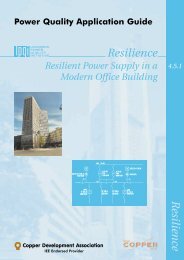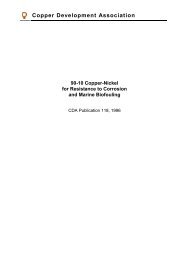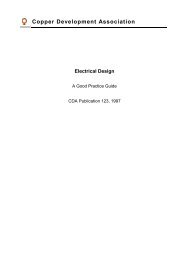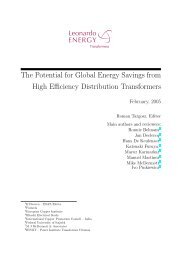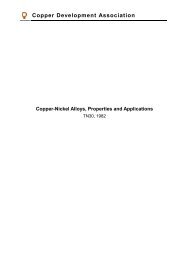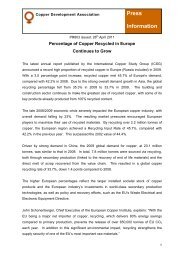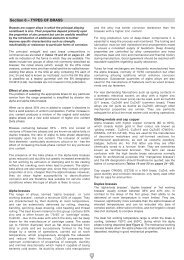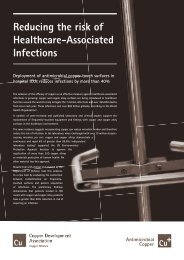Pub 41 Clear Protective Coatings for Copper and Copper Alloys
Pub 41 Clear Protective Coatings for Copper and Copper Alloys
Pub 41 Clear Protective Coatings for Copper and Copper Alloys
You also want an ePaper? Increase the reach of your titles
YUMPU automatically turns print PDFs into web optimized ePapers that Google loves.
<strong>Copper</strong> Development Association<strong>Clear</strong> <strong>Protective</strong> <strong>Coatings</strong><strong>for</strong> <strong>Copper</strong> <strong>and</strong> <strong>Copper</strong> <strong>Alloys</strong><strong>Pub</strong>lication TN<strong>41</strong>, 1991
<strong>Clear</strong> <strong>Protective</strong> <strong>Coatings</strong> <strong>for</strong><strong>Copper</strong> <strong>and</strong> <strong>Copper</strong> <strong>Alloys</strong><strong>Pub</strong>lication TN<strong>41</strong>August 1981Members as at 31 st December 1990ASARCO IncBoliden MKM LtdThomas Bolton LtdBP Minerals International LtdBr<strong>and</strong>eis LtdThe British Non-Ferrous Metals FederationChile <strong>Copper</strong> LtdCIPECColumbia Metals LtdFalconbridge LtdGecamines CommercialeHighl<strong>and</strong> Valley <strong>Copper</strong>IMI plcInco Europe LtdMinpeco (UK) LtdNor<strong>and</strong>a Sales Corporation of Canada LtdPalabora Mining Co LtdRTZ LtdSouthern Peru <strong>Copper</strong> CorporationWednesbury TubeAcknowledgements<strong>Copper</strong> Development Association is grateful to the Deutsches Kupfer-Institut in Berlin <strong>and</strong> <strong>Copper</strong>Development Association Inc in New York <strong>for</strong> permission to use the results of their research work <strong>and</strong> <strong>for</strong>helpful discussions.We are also indebted to Mr Brian Green of W Canning Materials Ltd <strong>for</strong> much technical advice.A number of companies have kindly provided the illustrations. Each is acknowledged separately.Thi j t h b f d d b th I t ti l C A i ti Ltd<strong>Copper</strong> Development Association<strong>Copper</strong> Development Association is a non-trading organisation sponsored by the copper producers <strong>and</strong>fabricators to encourage the use of copper <strong>and</strong> copper alloys <strong>and</strong> to promote their correct <strong>and</strong> efficientapplication. Its services, which include the provision of technical advice <strong>and</strong> in<strong>for</strong>mation, are available tothose interested in the utilisation of copper in all its aspects. The Association also provides a link betweenresearch <strong>and</strong> user industries <strong>and</strong> maintains close contact with other copper development associationsthroughout the world.Website: www.cda.org.ukEmail: mail@copperdev.co.ukCopyright:All in<strong>for</strong>mation in this document is the copyright of <strong>Copper</strong> Development AssociationDisclaimer: Whilst this document has been prepared with care, <strong>Copper</strong> Development Association can giveno warranty regarding the contents <strong>and</strong> shall not be liable <strong>for</strong> any direct, indirect or consequential lossarising out of its use
Applications where a <strong>Clear</strong> Surface Coating could be Used<strong>Copper</strong> <strong>and</strong> copper alloys such as brass <strong>and</strong> bronze are well known <strong>for</strong> their strength, corrosionresistance <strong>and</strong> attractive colours. This range of properties has resulted in their use in a wide variety ofapplications <strong>for</strong> both functional <strong>and</strong> decorative purposes.In architecture, <strong>for</strong> example, copper is an ideal roofing material. It is beautiful <strong>and</strong> durable requiringlittle or no maintenance <strong>and</strong> it can be applied easily <strong>and</strong> economically. It is also comparatively light inweight when considered against other roofing materials, so that savings can be made in the timbersubstrates. <strong>Copper</strong> cladding provides an elegant <strong>and</strong> durable facade to buildings, <strong>and</strong> copper alloyrailings <strong>and</strong> ballustrades create a sophisticated finish.Brass is one of the best materials <strong>for</strong> architectural hardware because of its attractive colour <strong>and</strong>corrosion resistance. It is widely used <strong>for</strong> such items as h<strong>and</strong>les <strong>and</strong> locks <strong>and</strong> letterboxes. Insidebuildings it adds a touch of sophistication to switch plates, socket covers, h<strong>and</strong>rails, taps <strong>and</strong> lampsalong with numerous other fixtures <strong>and</strong> fittings.<strong>Copper</strong> itself <strong>and</strong> many of its alloys tarnish slowly when exposed to the atmosphere. In someapplications, <strong>for</strong> example roofing, the effect of this gradual colour change is actively sought after.Architects may choose to design with this in mind, knowing that after a few years the roof will havetaken on an attractive green patina. It is also possible to produce this patina by chemical treatment, sothat the appearance of any stage in the weathering process can be chosen. The surface can bepreserved at any stage by the application of a clear protective coating.A bright polish on brass hardware items can be protected using tough, abrasion-resistant coatings thatwill withst<strong>and</strong> daily h<strong>and</strong>ling <strong>and</strong> use. Decorative items also, from inexpensive brass ornaments tounique bronze sculptures, both ancient <strong>and</strong> modern, can be protected from the atmosphere, <strong>and</strong> theirbeauty preserved, by the application of an appropriate clear coating.There is an enormously wide range of such clear coatings available, many of which are <strong>for</strong>mulated <strong>for</strong>particular service conditions, <strong>and</strong> it is essential that the most appropriate coating is chosen <strong>for</strong> eachapplication. Inappropriate choice of coating will lead to failure in service <strong>and</strong> rapid deterioration ofthe appearance of the metal surface.<strong>Copper</strong> <strong>and</strong> <strong>Copper</strong> <strong>Alloys</strong><strong>Copper</strong> is used in an unalloyed state or with small additions of alloy elements <strong>for</strong> a very wide varietyof applications. Many uses employ its excellent electrical <strong>and</strong> thermal conductivities <strong>and</strong> others resultfrom its strength, malleability <strong>and</strong> corrosion resistance.It has been known since prehistoric times that copper can readily be alloyed with other metals giving arange of materials with widely varying, useful properties. The best known of these early materials isbronze, an alloy of copper <strong>and</strong> tin which is still in wide use today. Phosphor bronzes are copper-tinalloys containing small additions of phosphorous. They are known <strong>for</strong> their excellent wear resistance<strong>and</strong> good spring properties, <strong>and</strong> are also used <strong>for</strong> "copper" coinage. Gunmetals are copper-tin alloyswith small amounts of other alloying elements used particularly <strong>for</strong> castings.The term "bronze" can, however, be misleading now because it has become used to cover a numberof completely different alloys. Manganese bronze is made from copper, zinc <strong>and</strong> manganese <strong>and</strong> isreally a high tensile brass. Manganese brass is a similar alloy but does not have quite such goodmechanical properties. Manganese containing alloys can be oxidised to an attractive chocolate browncolour <strong>and</strong> are often used <strong>for</strong> architectural purposes. Aluminium bronzes are a family of alloys basedon copper <strong>and</strong> aluminium. They have particularly good strength <strong>and</strong> corrosion resistance coupled witha distinctive pale yellow colour.Brass is made by adding zinc to copper. Brasses are harder <strong>and</strong> stronger than copper <strong>and</strong> are yellowin colour. Gilding metals are brasses with less than 20% zinc. They are known <strong>for</strong> their golden2
yellow appearance <strong>and</strong> are used <strong>for</strong> architectural purposes <strong>and</strong> <strong>for</strong> costume jewellery. A large numberof brasses are in common use with different amounts of zinc <strong>and</strong> other alloying elements.<strong>Copper</strong>-nickels or cupro-nickels are, as their name implies, alloys of copper with nickel. They haveexcellent corrosion resistance in the most arduous environments. Nickel-silvers, however, contain nosilver at all. They are alloys of copper <strong>and</strong> nickel with some zinc. They are so named because of theirwhite colour.The coatings described in this booklet are suitable <strong>for</strong> use on any of these alloys, but <strong>for</strong> advice onchoosing the most appropriate coating it is essential to discuss requirements with the coating supplier.Surface tarnishing of copper <strong>and</strong> copper alloysDespite their excellent resistance to corrosion, polished copper <strong>and</strong> copper alloys do eventuallytarnish on exposure to normal, moist atmospheres. However, the original finish can quickly berestored using recommended metal polishes.Tarnishing on copper <strong>and</strong> most of its alloys proceeds with the gradual build up of an oxide film whichcauses darkening of the surface until a deep brown colour is obtained. Eventually, after a number ofyears, a green colouration develops due to the <strong>for</strong>mation of copper salts (mainly sulphate <strong>and</strong>carbonate). This ‘patina’ is protective <strong>and</strong> self healing <strong>and</strong> the corrosion rate of the underlying metalis reduced to a negligible amount when the patina is fully developed. All the colours which aredeveloped during the growth of the patina can be reproduced by chemical treatment <strong>and</strong> this isfrequently used to create a particular effect.Aluminium bronzes <strong>and</strong> copper-nickel alloys behave rather differently from the other copper alloys.Aluminium bronzes quickly <strong>for</strong>m a strong, tenacious, protective oxide film. It is, there<strong>for</strong>e, not easyto retain a very bright polish on these materials, but the oxide film will, under normal conditions,prevent the growth of a brown, oxide film, so the attractive, pale golden colour of alloy is retained.<strong>Copper</strong>-nickel alloys also develop a very stable oxide film which effectively prevents furtheroxidation of the metal surface, <strong>and</strong> results in the metal having a dull grey colour. Both aluminiumbronzes <strong>and</strong> copper-nickels are ideal materials <strong>for</strong> use in exposed positions, especially in marineenvironments.Recommendations <strong>for</strong> the choice of coatingThe International <strong>Copper</strong> Association has funded the development of coatings specially <strong>for</strong>mulated<strong>for</strong> use on copper <strong>and</strong> its alloys. This work has resulted in a number of recommendations but the onlycoating available commercially as a direct result of this work is "Incralac"."Incralac" is a solvent-based, air drying acrylic resin coating which can be applied by any of themethods commonly used <strong>for</strong> solvent-based coatings. It contains an addition of benzotriazole whichacts as a most effective corrosion inhibitor ensuring that the underlying metal will not tarnish evenwhere the film is damaged. It has a high clarity <strong>and</strong> is resistant to degradation by ultra-violet light. Itwas <strong>for</strong>mulated primarily <strong>for</strong> use by the metal maintenance industry <strong>and</strong> has been used <strong>for</strong> suchprestige applications as the roof of the Sports Palace in Mexico City which has a surface area of21,000m2. It has been shown to provide protection <strong>for</strong> more than 10 years. It is also available <strong>for</strong>small scale applications such as statuary <strong>and</strong> domestic items.Soluble fluoropolymer coatings have recently been developed by a number of manufacturers <strong>for</strong>architectural applications, <strong>and</strong> these show dramatically improved durability. Experience of their useon copper <strong>and</strong> copper alloys is being built up."Incralac" <strong>and</strong> other commercially available coatings based on acrylic resin mixtures have excellentweathering resistance <strong>and</strong> do not discolour on ageing, but <strong>for</strong> applications where scratch <strong>and</strong> abrasionresistance are important it is necessary to use a tougher coating such as one of those based onpolyurethane resin. ICA sponsored research has shown that a solvent-based mixture containing apolyurethane resin with a polyisocyanate curing agent, benzotriazole to inhibit corrosion <strong>and</strong> ultra-3
violet absorbers will give a long-lasting <strong>and</strong> durable coating which does not discolour on ageing. Thecoating must be stoved <strong>for</strong> 15 minutes at 100°C. Site tests have shown that excellent protection isaf<strong>for</strong>ded, even under very severe h<strong>and</strong>ling, <strong>for</strong> at least eight years (ref. 5). This coating was originallymarketed as BNF/CB but is not now available under this name. However, most UK coatingmanufacturers have their own <strong>for</strong>mulations of abrasion resistant polyurethane coatings.There have been extensive programmes of work to test commercial coatings in America (ref. 2) <strong>and</strong>Germany (ref. 3) which have recently been summarised (ref. 10). Un<strong>for</strong>tunately in neither programmeof work was it possible to give definitive recommendations, primarily because of the enormousvariety of subtlely different coatings on the market. Almost all the commercially available coatingscontain a mixture of polymers <strong>and</strong> a selection of additives. Readers will find sections in this bookletwhich give further in<strong>for</strong>mation about aspects of coatings which should help them to make an in<strong>for</strong>medchoice <strong>for</strong> their own application. Table 1 will act as a starting point <strong>for</strong> general advice on typicalapplications of different polymer types. In general it can be said that <strong>for</strong> outdoor applications acryliccoatings or soluble fluoropolymers are most suitable; acrylics are best <strong>for</strong> decorative items which areh<strong>and</strong>led rarely; <strong>and</strong> polyurethane coatings are more suitable <strong>for</strong> applications where the coating issubjected to abrasion <strong>and</strong> wear, <strong>and</strong> not likely to suffer prolonged exposure to ultraviolet light.However, there can be no substitute <strong>for</strong> detailed discussions held with reputable coatingmanufacturers because only they will have experience of the per<strong>for</strong>mance of their own products in awide variety of circumstances.The eventual choice of coating will depend on the service conditions anticipated, the type <strong>and</strong> numberof items to be coated, <strong>and</strong> the method of application of the coating.Some of the test work (ref. 2, 3, 8) indicates that coatings <strong>for</strong> brass may need to be different fromthose used <strong>for</strong> other copper alloys, but this does not seem to be true in all cases. In all situations theadvice of a good supplier will be the most reliable guide.In general the user can be assured that when the correct choice of coating is made <strong>and</strong> it is properlyapplied, long <strong>and</strong> satisfactory service life can be expected.Conditions of ServiceIt is essential that the service conditions are clearly identified be<strong>for</strong>e a coating is chosen. It must bestressed that users should discuss their requirements with the coating supplier. The importantconsiderations are to establish:• whether the coating will be used indoors or outside• whether the atmosphere will be dry or humid• the degree of wear resistance required• the degree of impact resistance required• whether the coating can be renewed at regular intervals• whether it is important that the coating has a high degree of reflectivityPolymers Used <strong>for</strong> <strong>Clear</strong> <strong>Coatings</strong>There are several different polymers which can be used to make a clear coating. Each one hasparticular attributes <strong>and</strong> they may be used either singly or in combination with each other to obtain acoating with the required properties. Most types can be prepared <strong>for</strong> any of the application methodsdiscussed in this booklet.The types of polymer are listed <strong>and</strong> described in Table 1, along with typical areas of application.4
Table 1 - Polymers Used <strong>for</strong> <strong>Clear</strong> <strong>Coatings</strong>Polymer Film Properties Typical applicationAcrylicAvailable in air-drying or thermosettingcompositions, acrylics are relatively highcost materials. The airdryingmodifications are popular <strong>for</strong> exteriorapplications. The thermosetting types areuseful <strong>for</strong> applications requiring highresistance to heat <strong>and</strong> abrasion. Theaddition of a chelating agent suchasbenzotriazole gives good protectionagainst tarnishing occurring under thelacquer.Since the thermosetting coatings arenot easily stripped off <strong>for</strong> re-coating,they are not normally suitable <strong>for</strong>major architectural applications. Thecopper roof of the Sports Palace inMexico City is covered with Incralac,an inhibited air-drying acrylic lacquer<strong>for</strong>mulated also with an ultra-violetabsorber.Modified acrylicEpoxyAcrylic resins can be modified withpolyisocyanate, polyurethane, amino <strong>and</strong>other resins to produce crosslinkedsystems with good mechanical strength,abrasion resistance, flexibility <strong>and</strong>adhesion.Epoxy coatings have excellent resistanceto wear <strong>and</strong> chemicals. They arerelatively expensive <strong>and</strong> are available inthermosetting or two-part compositions,the latter having a relatively short potlife. They are good <strong>for</strong> severe indoorapplications, but they darken in a fewmonths of exterior service.These lacquers are durable <strong>and</strong> havegood resistance to chemicals.Outst<strong>and</strong>ing adhesion <strong>and</strong> protection<strong>for</strong> copper surfaces used indoors.Modified epoxyNitrocelluloseCellulose acetatebutyrate <strong>and</strong> propionatePolyurethaneThe most important combinationpartners are phenoli or amino resins <strong>for</strong>improving elasticity, impact resistance,hardness <strong>and</strong> abrasion resistance.These are less expensive <strong>and</strong> the mostcommon air drying coatings <strong>for</strong> interiorservice. They are modified with alkyd,acrylic, polyurethane <strong>and</strong> other resins.They do not have high resistance tochemicals, but they are fast drying <strong>and</strong>easy to use.These coatings have a cost comparablewith acrylics. They can be used alone orto modify acrylics or alkydsTough <strong>and</strong> flexible films with goodadhesion. They have good abrasionresistance <strong>and</strong> are resistant to chemicals.Available in both single <strong>and</strong> twocomponent <strong>for</strong>mulations. Some <strong>for</strong>msare prone to yellow with time. Theydarken on exposure to elevatedtemperatures.Ideal <strong>for</strong> severe service such asbathroom taps.Mainly used <strong>for</strong> interior applications.They can be used outdoors, but theyare usually stripped <strong>and</strong> replaced atintervals of less than one year.Could be used <strong>for</strong> interior or exteriorapplications.Good <strong>for</strong> all interior applications.5
VinylSiliconePolymer Film Properties Typical applicationVinyl films are flexible <strong>and</strong> resistantwith goodadhesion. Stabilisation isrequired.Silicones provide the best potential <strong>for</strong>coatings which must operate at elevatedtemperatures. They have excellentresistance up to 250°C. Thin films ofthese high-cost coatings are sometimesused with protection by a second coat ofa more durable, abrasion-resistantlacquer. They require extended curing athigh temperatures, <strong>and</strong> this may causediscolouration of the copper surface.Very good protection <strong>for</strong> interiorapplications. Good <strong>for</strong> exteriorapplications provided they are wellstabilised.High temperature applicationsAlkydSlow drying or baking is required whenapplying the alkyd coatings. They can bemodified with melamine or urea resins.They have a low-cost <strong>and</strong> are sufficientlydurable <strong>for</strong> exterior applications,although yellowing may occur.Resistance to chemicals is usually good.Domestic applications where highwear resistance is required.Soluble fluoro polymerWill cure to full hardness at ambienttemperature or can be stoved toaccelerate hardening. Resistant toweathering <strong>and</strong> ultra-violet light.Excellent protection with 20 years lifeexpectancy <strong>for</strong> exterior applications.Suitable <strong>for</strong> coil coating or on-siteapplication.Types of Coating<strong>Coatings</strong> may be made from any of the polymers listed in Table 1, <strong>and</strong> the basic properties of thecoating are defined by the constituent polymer or polymers, but the properties are also controlled bythe way in which the coating is prepared <strong>and</strong> applied. There are four different types of coating:• solvent-based coatings, air dried or stoved• powder coatings• coatings prepared in sheet <strong>for</strong>m <strong>and</strong> stuck onto the surface• radiation cured coatingsSolvent-based coatingsIn order to apply a coating in liquid <strong>for</strong>m the film-<strong>for</strong>ming polymer (or mixture of polymers) must bedissolved or dispersed in a suitable liquid. This type of coating is frequently referred to as a "lacquer"* . Increasing awareness of the environmental <strong>and</strong> health hazards associated with volatile organic* The word "lacquer" has an Indian origin (in Sanskrit "laksha" means hundred thous<strong>and</strong>s, derivedfrom the thous<strong>and</strong>s of cochineal insects used to make shellac.) It also conveys the implication of themultiple possibilities that lacquer in itself holds. Because of their moisture resistance lacquers were<strong>for</strong>merly applied by Egyptians <strong>and</strong> the Incas to embalm the dead <strong>and</strong> were connected with the notionof indestructability (ref. 3). 16
solvents has lead to the development of coatings which have water as the main solvent <strong>and</strong> many suchare now available.The coating is applied to the surface, the solvent evaporates <strong>and</strong> the coating film <strong>for</strong>ms. Somecoatings may simply be allowed to air-dry, others require gentle heating to speed up the process.Some polymers require stoving to complete a cross-linking reaction.Air-drying <strong>for</strong>mulations have the advantage that no drying or baking equipment is required, but caremust be taken to protect the wet coating from dust which will spoil its appearance. Humidity in theatmosphere may also cause defects. The coatings take some time to reach a fully hard state <strong>and</strong> whilstthey are still soft they are vulnerable to damage.Stoved coatings are generally harder <strong>and</strong> more wear resistant than air drying, non cross-linked ones,but care must be taken to ensure that the metal surface does not discolour during the stoving process.It is wise to use as low a temperature <strong>and</strong> as short a time as possible. In some cases the copper surfacecatalyses the cross-linking reaction thus enabling lower temperatures or shorter times to be used.When a coating is being <strong>for</strong>mulated it is generally necessary to include a number of ingredients otherthan the solvent <strong>and</strong> the basic film <strong>for</strong>ming polymers. Many different types of additives may be used.They have a wide range of functions such as to improve film properties or to ensure that the coating ismore easily applied. All the constituents of a coating solution must be considered <strong>for</strong> a particularapplication in order to ensure that optimum per<strong>for</strong>mance is obtained.(i) SolventsResearch shows (ref. 1, 4, 11) that a number of organic solvents are unsuitable <strong>for</strong> use on copper <strong>and</strong>copper alloys because they tend to discolour the metal. This discolouration occurs either at the time ofapplication or later even under a non-porous coating, due to the breakdown of residual solvents onexposure to ultra-violet radiation. Ethyl alcohol <strong>and</strong> isopropyl alcohol have been found to causestaining, but no problems have been experienced with toluene or xylene or their derivatives so theseshould be used. Due care must, of course, be taken to ensure that health <strong>and</strong> safety requirements aremet during the h<strong>and</strong>ling of these solvents.Fewer hazards are associated with water-based coatings, but not all coating systems can be adapted toaqueous solutions or dispersions <strong>and</strong> in some cases the desired properties cannot be achieved using awater-based system. Difficulties can also be encountered with surface tension effects preventing thecoating from wetting the surface properly, particularly when the coating is applied by spraying.(ii) Additives <strong>for</strong> solvent-based coatingsThe quality <strong>and</strong> per<strong>for</strong>mance of a coating can often be improved by the addition of compounds otherthan the film <strong>for</strong>ming polymers. These additives have many different functions. The most commonlyfound types are: ultra-violet absorbers, antioxidants, chelating agents, plasticisers <strong>and</strong> levellingagents.Ultra-violet absorbersThese are organic compounds which are often added to coatings which will be used <strong>for</strong> exteriorapplications. They absorb the ultra-violet radiation from sunlight <strong>and</strong> this prevents darkening <strong>and</strong>degradation of the coating.7
AntioxidantsThese are required only in some types of coating. They help to reduce the degradation of coatingsduring long <strong>and</strong> severe exposure.Chelating AgentsChelating agents are preferentially adsorbed on the surface of the metal <strong>and</strong> act as an invisible barrierto elements or compounds which might cause corrosion. In this way they protect the metal againstoxidants permeating through the coating <strong>and</strong> continue to protect even after a minor defect has <strong>for</strong>medin the coating. They may be included as part of a coating <strong>for</strong>mulation or applied as part of a pretreatmentprocedure. The most commonly used chelating agent <strong>for</strong> copper <strong>and</strong> copper alloys isbenzotriazole. This has been found to provide exceptionally good protection (ref. 1).PlasticisersPlasticisers improve the flexibility of a film <strong>and</strong> in some cases improve adhesion. They are added incases where a particularly tough <strong>and</strong> resistant film is required.Levelling AgentsLevelling agents improve the flow properties of coatings thereby ensuring a better surface appearance.They prevent runs <strong>and</strong> also reduce the likelihood of pinholing <strong>and</strong> other defects.Powder <strong>Coatings</strong>The film <strong>for</strong>ming polymer (or mixture of polymers) is prepared in the <strong>for</strong>m of a fine powder which isapplied to the surface to be coated. The powder particles should generally be in the size range 20-40microns. The powder-coated surface is subsequently heated which causes the powder particles tosoften <strong>and</strong> flow out to <strong>for</strong>m a continuous surface film. The type of polymer used determines whetherthe film is described as thermoplastic or thermosetting. In the <strong>for</strong>mer, the film hardens on cooling butcould be resoftened simply by heating again. In the latter, a chemical reaction takes place duringheating <strong>and</strong> causes the film to harden. A thermosetting film cannot be softened again just by heatingto the curing temperature.Besides the primary film <strong>for</strong>ming polymer (or mixture of polymers) a powder coating generallycontains a number of additives, some of which are essential <strong>for</strong> a satisfactory coating but many areoptional <strong>and</strong> specific <strong>for</strong> certain end-uses.(i)Additives <strong>for</strong> powder coatingsWetting AdditivesThese are necessary to allow the coating to flow out <strong>and</strong> wet the substrate surface.Air Release AgentsThe release of interstitial air as the powder fuses is important, because entrapped air causes pinholedefects in the coating. Air release agents provide a very low viscosity coating on the powder particlesas they fuse, <strong>and</strong> allow all the air to escape.CatalystsThe curing reaction of the resin in the coating may be accelerated by the use of a catalyst, howevercare must be taken because the faster reaction always results in a poorer flow-out <strong>and</strong> an unevencoating may result.8
Slip AidsThese improve the surface slip properties of the powder coatings <strong>and</strong> reduce the marring which occurswhere two coated surfaces rub against each other.Gloss Control AgentsCertain oils or waxes can be added to coatings to cause a very fine "micro-wrinkle" on the surfacewhich reduces the gloss. A similar effect can be achieved in some cases by using a mixture of tworesin powders which have different cure rates. Care must be taken to ensure that the surfaceunevenness is not so great that an "orange peel" effect is seen.<strong>Coatings</strong> applied in sheet <strong>for</strong>mA considerable amount of work has been done to develop <strong>and</strong> evaluate coatings which areapplied in sheet <strong>for</strong>m <strong>and</strong> glued to the metal surface (ref. 7). They can be applied to copper sheet <strong>and</strong>coil be<strong>for</strong>e the sheet is <strong>for</strong>med to shape <strong>and</strong> will de<strong>for</strong>m when the sheet is shaped without decoheringor breaking. The most successful film investigated was a polyvinyl fluoride with the trade nameTedlar R (registered trademark of Du Pont Co) which was roll-bonded to the metal surface using anadhesive containing benzotriazole as a corrosion inhibitor. The coating was marketed as "Incracoat".The roof of Regents Park Mosque in London is made of gilding metal sheet protected in this way, <strong>and</strong>its glowing colour is a tribute to the success of the method. Dem<strong>and</strong> <strong>for</strong> the product has, however,been low <strong>and</strong> "Incracoat" is no longer commercially available <strong>and</strong>, as far as is known, no othercoating systems of this type <strong>for</strong> copper <strong>and</strong> copper alloys have been developed.Radiation cured coatingsThese coatings are applied as liquid monomers or oligomers. They do not contain solvents. Afterapplication to the metal surface they are irradiated either by passing them through an electron beam orthrough a beam of ultra-violet light. The radiation releases catalysts in the coating mixture whichinitiate the polymerisation reaction <strong>for</strong>ming the solid film. It is essential that there are no radiationshadows on the component so these coatings are normally only used on flat surfaces. They have theoutst<strong>and</strong>ing advantage that the process does not require heat, so they can be used on very thin sheetsof metal without fear of distortion occurring. They are used <strong>for</strong> printed circuits, <strong>and</strong> are applied byroller coating or screen printing.Methods of Application of <strong>Coatings</strong>The most appropriate method of application of a coating will depend on the choice of polymer <strong>and</strong> thecoating type, on the number of items to be coated, <strong>and</strong> on their shape; <strong>and</strong> it will, of course, also beinfluenced by the capital cost of equipment <strong>and</strong> its availability. Again it must be stressed that adviceshould be sought from the coating supplier.It is also vitally important that the coating is correctly applied by the chosen method. Many defectsseen in coatings are the result of poor methodology during the coating process. Defects such as thefilm being too thick or too thin, or the inclusion of dust particles can be eliminated if good practice isensured. (Further in<strong>for</strong>mation about defects can be found in 'Defects Which May Occur in <strong>Coatings</strong>').Solvent-Based <strong>Coatings</strong>Solvent-based coatings may be applied in a number of different ways. Each method has its advantages<strong>and</strong> disadvantages, <strong>and</strong> considerations such as the cost of the equipment, the requirements <strong>for</strong> skilledlabour, the amount of coating lost during the process <strong>and</strong> the necessity <strong>for</strong> fume control, must betaken into account. Table 2 gives details of the methods available <strong>and</strong> includes comments on eachone.9
Table 2 - Typical application methods <strong>for</strong> solvent-based coatingsMethodBrushingDippingFlow coatingRoll coatingCurtain coatingCompressed air sprayAirless, or high pressure sprayElectrostatic sprayElectrophoretic coatingRemarksA commonly used method <strong>for</strong> small scale applications. There isefficient use of the coating <strong>and</strong> capital costs are low, but it islabour intensive. The viscosity of the coating must be carefullycontrolled. Skill is required to produce films of uni<strong>for</strong>m thicknessfree from runs.A traditional application method still useful with h<strong>and</strong> ormechanised techniques. The dip cycle must be slow in order toreduce air entrapment during immersion <strong>and</strong> to permit gooddrainage on extraction.Similar in effect to dipping but the components are flooded withlacquer in an enclosed cabinet. Excess lacquer is recycled.An automated process <strong>for</strong> coating strip either on one side or onboth sides simultaneously. A high st<strong>and</strong>ard of quality is obtained.An automated process <strong>for</strong> coating sheet <strong>and</strong> strip. The metalpasses through a "waterfall" of the coating liquid.A conventional method of application using small, medium orlarge spray guns <strong>and</strong> nozzles. 1-2m2/min coverage is obtained.Automation is possible but otherwise skill is needed to obtain auni<strong>for</strong>m film thickness. Overspray leads to inefficient utilisationof the coating <strong>and</strong> fume extraction can be a problem.Can achieve greater efficiency than with conventional compressedair spray. Coverage up to 6m2/min is possible. Inclusion of airbubbles <strong>and</strong> the occurrence of runs are less frequent.Electrostatically charged droplets of spray are attracted bycharged components. The process gives good, even coverage tocomplex parts including those with sharp edges. It is easilyautomated <strong>and</strong> gives relatively efficient usage of coating mixture.An aqueous dispersion of the coating mixture <strong>for</strong>ms the eletrolyteof an electrolytic cell. The component is immersed in the cell <strong>and</strong><strong>for</strong>ms one of the electrodes. For coating copper <strong>and</strong> brass thecomponent must <strong>for</strong>m the cathode. The coating is quickly applied<strong>and</strong> is of uni<strong>for</strong>m thickness, even over sharp edges <strong>and</strong> recessedareas, making the process very useful <strong>for</strong> articles with intricatedesigns <strong>and</strong> re-entrant areas. It is particularly suitable <strong>for</strong>continuous production. The articles do not need to be dried aftercleaning. Investment in plant is repaid by low losses of coatingmixture, good surface quality, low production costs <strong>and</strong> minimalfume problems. Skilled maintenance of the plant is essential <strong>and</strong>care must be taken to avoid contamination of the electrolyte.10
Powder <strong>Coatings</strong>These may be applied either by electrostatic spraying or dipping.Electrostatic sprayThis is the most usual method <strong>for</strong> application of powders. The powder particles are charged <strong>and</strong>directed towards the article to be sprayed which is held at earth potential. The powder is deposited<strong>and</strong> held onto the surface by the electrostatic <strong>for</strong>ce. Subsequent heating melts the powder causing it toflow out to <strong>for</strong>m a continuous film, <strong>and</strong> finally it sets.Fluidized bed dippingThe article to be coated is heated <strong>and</strong> dipped into the fluidized powder which melts onto the surface.Recently, fluidized beds containing electrostatically charged particles have been developed, enablinga cold object to be coated by dipping. The article must then subsequently be heated in order to <strong>for</strong>m acontinuous coating.Surface PreparationThe importance of good surface preparation cannot be emphasised too strongly. It is absolutelyessential that the surface is properly cleaned be<strong>for</strong>e a coating is applied whatever the chosen methodof application. The majority of coating failures in service are due to inadequate surface preparation. Insome instances, where a coating is being applied to a plated metal surface, faults may occur in theclear protective coating which stem from inadequate control of the plating operation, even though theplating itself appears to be sound. The per<strong>for</strong>mance of an inherently good coating will be severelyimpaired if it is applied to a dirty surface.When cleaning <strong>and</strong> polishing it is important to avoid the use of steel wool <strong>and</strong> polishing rouges whichcontain iron. Pads such as "Scotchbrite" are a useful alternative to steel wool.All traces of polishing compounds, oil, debris <strong>and</strong> plating solutions must be removed be<strong>for</strong>e coating.There are a number of methods which may be used to clean the surface <strong>and</strong> these are set out <strong>and</strong>described in Table 3.After each chemical or electrochemical cleaning operation the articles to be coated must bethoroughly swilled clean in cold water. A cold pre-rinse is often followed by an intermediate hot rinsewith the objective of removing the remaining treatment chemicals from the smallest pores, threads<strong>and</strong> recesses. The last rinse is usually de-ionised or distilled water in order not to leave a residue onthe surface after drying. Be<strong>for</strong>e coating, the articles are often dried by hot air in an oven or continuoustunnel drier.11
Film ThicknessAdvice should be sought from the coatings supplier as to the optimum thickness <strong>for</strong> a particularcoating. If the coating layer is very thin interference colours can be seen <strong>and</strong> this is known as"rainbowing". Too thin a film may also tend to contain pinholes. Several applications of the coating inquick succession may be needed to build up the required thickness. In the case of INCRALAC, <strong>for</strong>example, several coats should be applied until a thickness of at least 25 microns is built up. If the filmis too thick it tends to become obvious <strong>and</strong> the metal appears to be varnished. Too thick a film canalso be uneven, giving a characteristic "orange peel" effect, or there may be runs or "tears" on thesurface.Dust ParticlesIt is very important to ensure that the coating is applied in a clean atmosphere. Dust <strong>and</strong> debris canvery easily become entrapped on the surface during application of the coating or whilst it is drying.Dust particles mar the appearance <strong>and</strong> tend to cause localised spots of corrosion on the underlyingsurface.BlushingThis is a particularly unsightly defect where a whitish colouration is seen in the film. It is caused bymoisture in the film <strong>and</strong> is seen particularly in air-drying coatings based on organic solvents. Rapidevaporation of the solvent causes cooling of the substrate, <strong>and</strong> this tends to lead to water condensingon the surface from a humid atmosphere.SpotsA spotty appearance will almost certainly be due to pinholes or dust in the film which have allowedcorrosion to occur on the metal surface.Poor AdhesionAny traces of oil or grease or polishing debris on the surface of the metal or in the coating materialwill tend to prevent the coating from adhering properly to the substrate. Good surface preparation isessential.Defects in Powder <strong>Coatings</strong>Many of the same defects are found in improperly applied powder coatings. Pinholes are frequentlythe result of entrapped air <strong>and</strong> an orange peel effect on the surface can be caused either by inadequateflow-out characteristics or by an incorrect choice of resin mixture which contains resins with differentcure rates.Defects in Stoved <strong>Coatings</strong> - both Solvent-based <strong>and</strong> PowderIf the stoving schedule is not strictly observed, faults may arise such as a soft film due to insufficienttime or too low a temperature; a brittle film, due to too high a temperature or too long a time;discoloration of the metal due to too high a temperature; or (in the case of solvent-based coatings)blistering due to stoving too soon after application of the coating.Further in<strong>for</strong>mation about defects in sprayed coatings <strong>and</strong> how they may be remedied can be found inreference 6.13
Testing <strong>Coatings</strong>Coating manufacturers supply data sheets describing the properties of their coatings. They use anumber of tests, some of which are briefly described in Table 4. In the case of resistance to specificenvironments the coatings are generally tested using these methods immediately after application <strong>and</strong>then again after exposure to the environment, <strong>and</strong> conclusions as to their resistance to theenvironment are drawn.In environmental testing, ideally the coatings should be exposed to real environments <strong>for</strong> long periodsof time, but this is rarely practicable <strong>and</strong> there are many tests devised which simulate severeenvironments. Examples found in the literature include:• Weatherometer• salt-spray cabinet• 50°C humidity cabinet• kitchen dishwasher• artificial perspiration cabinet• exposure to ultra violet light• thermal cycling• solvent resistanceTesting by the coating userBe<strong>for</strong>e the choice of coating is finalised, it is strongly recommended that samples should be testedunder conditions as similar as possible to the expected environmental conditions of service. Theper<strong>for</strong>mance of a coating will be strongly dependant on its situation, <strong>and</strong> some coatings are moresuitable than others <strong>for</strong> certain substrates. Users can set up their own tests, or they may be able todiscuss specific testing with the supplier.It is also important <strong>for</strong> the user to per<strong>for</strong>m a number of routine tests after a coating has been applied toensure that it has been applied correctly <strong>and</strong> that a good film has <strong>for</strong>med.Arguably the most important test is a visual check of the appearance of the coating. This will give animmediate impression of the metal surface condition, the uni<strong>for</strong>mity of the film, the occurrence ofdefects such as pitting or an "orange peel" effect, or the presence of dust inclusions. It will alsodetermine whether or not the film is fully dry. However, it is also advisable to make a few morequantitative measurements on a routine sampling basis. These might include adhesion, film thickness,hardness, impact resistance <strong>and</strong> flexibility. For these tests the methods described in Table 4 can beused.For cured coatings which undergo a crosslinking reaction during stoving, it is also important to checkthat the crosslinking reaction is fully completed. This can be done by using a solvent resistance test. Ifthe coating is not fully cured, it will quickly dissolve in the solvent.Tarnishing of the Metal SurfaceThe tests quoted in Table 4 are essentially tests of the coating itself. <strong>Clear</strong>ly, if the coating cracks orbreaks down there will be a tendency <strong>for</strong> the metal to tarnish in the damaged area. In some cases alsothe film itself becomes discoloured. However, there must also be some measure of the effectivenessof a good, adherant, clear coating <strong>and</strong> this is generally done by measuring changes in the colour of themetal surface over a period of time when the sample is exposed. Quantitative measurements of colour<strong>and</strong> darkness can readily be made, but a subjective decision about the amount of change which isacceptable has to be taken.14
Table 4 Commonly used Test Methods <strong>for</strong> Measuring Physical Properties of <strong>Coatings</strong> (ref. 2, 3, 9)Property Test Method RemarksThicknessEddy current Thickness upwards from 0.002mm (10%)GlossHardnessDifferential weighingRelative intensities ofincident <strong>and</strong> reflected lightbeams measuredShore scleroscope or pencilhardnessMore accurate <strong>for</strong> thin coatings. Results areusually expressed in g/m2 <strong>and</strong> not converted toactual thickness.The gloss measured is largely an indication ofthe reflectivity of the metal surface, althoughchanges in the coating can have an effectThe pencil hardness test involves drawing apencil lead across the surface. The valuequoted is the hardness of pencil which willcrumble itself rather than scratch the coatingImpact Resistance St<strong>and</strong>ard impact test The degree of starring of the coating isrecordedAbrasion ResistanceThere are severalst<strong>and</strong>ardised testsMost tests measure loss in weight due toAbrasionFlexibilityAdhesionBending over a conicalm<strong>and</strong>relDeep parallel cuts at rightangles are made in the filmto <strong>for</strong>m a grid of smallsquares. Adhesive tape ispressed over <strong>and</strong> thenlifted off.The amount of cracking is recordedThe number of squares remaining isrecordedFuture Developments in the Use of <strong>Clear</strong> <strong>Coatings</strong>In the past the major use of clear coatings was <strong>for</strong> decorative brass <strong>and</strong> copperware <strong>and</strong> <strong>for</strong>architectural decorative features. Increasingly now, as more wear-resistant coatings are beingdeveloped, the use is spreading to items requiring greater durability such as bathroom <strong>and</strong> kitchenfittings.<strong>Copper</strong> is enjoying an increasing use <strong>for</strong> architectural purposes. It is used <strong>for</strong> roofing, cladding <strong>and</strong>guttering, not only because of its beauty, but also because of its strength <strong>and</strong> comparatively lightweight when considered against other roofing materials. Architects are using clear coatings topreserve the copper in a particular state of patination rather than allowing the natural green colour todevelop.Prestige buildings are being enhanced with brass railings, ballustrades <strong>and</strong> banisters, <strong>and</strong> there is anincreasing use of copper alloy extrusions <strong>for</strong> window <strong>and</strong> door frames because their appearance issignificantly more beautiful than that of competitor materials. Long lasting coatings have beendeveloped <strong>for</strong> all these applications.<strong>Coatings</strong> which can be applied to sheet or strip be<strong>for</strong>e <strong>for</strong>ming are also being developed. Thesecoatings are sufficiently adherant <strong>and</strong> sufficiently plastic to de<strong>for</strong>m with the metal as it is shaped, <strong>and</strong>no cracking or decohesion occurs. Continuous line production of coated metal can be achievedresulting in considerable cost savings.15
Work is also being undertaken to develop coatings <strong>for</strong> engineering applications, <strong>for</strong> exampleautomotive radiators. In this particular application the very thin sheets from which the fins are madeare eventually susceptible to corrosion induced by salt on the roads. A protective coating must notimpair the heat transfer characteristics, <strong>and</strong> must be applied in such a way as to ensure that all theminute crevices are adequately covered.There is also a huge field of applications <strong>for</strong> coatings in the printed circuit industry which has notbeen discussed at all in this booklet.References1. N. R. Bharucha <strong>and</strong> M. T. Baker, "<strong>Clear</strong> lacquers <strong>for</strong> copper <strong>and</strong> copper alloys", British Non-Ferrous Metals Research Association Report RRA 1569, July 1965, 40 pp.2. "The properties of clear organic coatings on copper <strong>and</strong> copper alloys", <strong>Copper</strong> DevelopmentAssociation Inc, Greenwich, USA3. "Lacquering of copper <strong>and</strong> copper alloys with translucent lacquer films", Deutsches-Kupfer-Institut, Berlin, Germany, 19914. "<strong>Clear</strong> organic finishes <strong>for</strong> copper <strong>and</strong> copper alloys", <strong>Copper</strong> Development Association Inc,Greenwich, USA5. N. R. Bharucha <strong>and</strong> M. T. Baker, "<strong>Clear</strong> polyurethane lacquer <strong>for</strong> copper <strong>and</strong> copper alloys", CDAInc/ASM Conference, Clevel<strong>and</strong>, Ohio, October 1972.6. "Canning H<strong>and</strong>book on Electroplating", W. Canning Materials Ltd, Birmingham7. R. S. Lindstrom, A.D. Little Inc. "<strong>Protective</strong> <strong>Coatings</strong> <strong>for</strong> <strong>Copper</strong> Metals", INCRA Project No 97,Final Report 1971, International <strong>Copper</strong> Association (ICA) New York, USA <strong>and</strong> Potters Bar, UK.8. D. M. Lyde, (Albright & Wilson Ltd), private communication, 19879. "Lacquer Test Methods", W Canning Materials Ltd, Birmingham10. V. A. Callcut, A. Segal <strong>and</strong> B Green, "<strong>Clear</strong> lacquers <strong>for</strong> copper, brass <strong>and</strong> other copper alloys",Institute of Metal Finishing, Annual Technical Conference, Torquay, April 199111. S. Spindel, "The development of a durable coating <strong>for</strong> copper <strong>and</strong> brass", American Paint Journal,October 19 1970.Other useful literature"<strong>Clear</strong> lacquers <strong>for</strong> plated parts", Metal Finishing, 50 (1952) 101, pp57-59G. A. Cypher <strong>and</strong> L. D. Fitzgerald, "New finishes on copper <strong>and</strong> its alloys", ASM/AIME AnnualCongress, October 1971, Detroit, MichiganH. S. Campbell "<strong>Clear</strong> organic finishes <strong>for</strong> copper <strong>and</strong> copper alloys", CDA seminar "Surface finisheson copper <strong>and</strong> copper alloys", Birmingham, October 1983"Lacquers - Technical data", W. Canning Materials Ltd, Birmingham"Electrolac clear cathodic electrophoretic lacquer N.65394",Instruction sheet No. 2224A, W. Canning Materials Ltd, Birmingham"Lacquers <strong>for</strong> Brass". <strong>Pub</strong>lication N.S. 235. 1987. W. Canning Materials Ltd, BirminghamJ. Martin et al, "Improved corrosion resistant coating or surface treatment <strong>for</strong> automobile radiators",INCRA Project No. <strong>41</strong>5, Final Report, June 1990, International <strong>Copper</strong> Association.J. J. Bikerman, "The development of clear polyfluorocarbon coatings <strong>for</strong> copper <strong>for</strong> architecturalapplications", INCRA Project No. 73, Final Report 1965, International <strong>Copper</strong> Association.16
IllustrationsThe ornamental container is coated withERCALENE which is an air dryinglacquer, <strong>and</strong> the door h<strong>and</strong>les are protectedwith the stoving system STACRYL. Allthe items have been coated by aconventional spraying technique. Theprocess can readily be adapted <strong>for</strong> coatinglarge batches of components or smallnumbers of items.(W Canning Materials Ltd)Brass articles protected with durable clear coatingsWhen the article to be coated has re-entrantareas it is difficult to ensure an evencoating using a spray technique. Anelectrophoretically deposited coatingovercomes this problem. CanningsELECTROLAC clear cathodicelectrophoretic lacquer is a water-basedcoating yielding a tough, glossy resilientfilm. It gives all-over, drip-free coverage tothe most complex of shapes.Articles with complex shapes <strong>and</strong> re-entrant areascoated by electrophoresis(W Canning Materials Ltd)17
(LVH <strong>Coatings</strong> Ltd)Decorative <strong>and</strong> functional items protected with CLEARCLADCLEARCLAD is an electrophoretically deposited, water-based coating system based on anacrylic/urethane resin mixture stoved at 150°C. It is resistant to abrasion <strong>and</strong> does not degrade inultra-violet light. The electrophoretic process ensures an even coating on the most intricately shapedcomponents even when the process is automated. The water-based mixture is less hazardous thanconventional organic solvent-based coatings, posing few environmental problems. The manufacturerof the door h<strong>and</strong>le has been able to increase the production rate of his components up to four-folddue to the advantages of the CLEARCLAD process.18
Brass plated furniture protected with ELECTROCLEAR 2000(OMI-IMASA Ltd)ELECTROCLEAR 2000, based on an acrylic/amine/urethane mixture, gives hard, durable coatingswith an excellent gloss. It can be used either on polished brassware or on articles which have beenelectroplated with brass. The coating is deposited by electrophoresis from aqueous solution <strong>and</strong> thenstoved <strong>for</strong> 10 minutes at 160°C.Mexico City Sports PalaceThis building was constructed <strong>for</strong> the 1968 Olympics with a facetted dome, comprising some21,000m2 of unprotected copper. In most parts of the world it would be expected to weather to anattractive green patina, but in the dry Mexican climate only a patchy grey colour developed after twoyears. It was there<strong>for</strong>e decided to restore <strong>and</strong> preserve the original metallic copper colour by cleaningit <strong>and</strong> applying INCRALAC.19
The roof of Regents Park Mosque is madeof gilding metal sheet (copper-10% zinc)protected with "INCRACOAT". The sheetfilm was roll-bonded to the metal using anadhesive containing benzotriazole as acorrosion inhibitor. (Un<strong>for</strong>tunately"Incracoat" is no longer commerciallyavailable.)Regents Park Mosque in LondonEnfield Rolling Mills in North LondonThis copper roof, situated in an industrial environment, was carefully prepared <strong>and</strong> coated withseveral coats of INCRALAC, ensuring that the film was of optimum thickness. The lacquer wasexpected to last <strong>for</strong> five years, but the picture shows the roof 20 years after it was coated. Norecoating or repair has been undertaken, <strong>and</strong> it can be seen that the copper is still fully protected(although the steel hinge is looking the worse <strong>for</strong> wear). This example clearly demonstrates thebenefits of scrupulous attention to detail during preparation of the surface <strong>and</strong> coating application.(Delta Enfield Metals)20
This switchplate, designed to withst<strong>and</strong>repeated h<strong>and</strong>ling, is protected with athermosetting polyester powder coating.The curing schedule is ten minutes at ametal temperature of 170°C. The coatingshows excellent resistance to abrasion,impact, humidity <strong>and</strong> weathering.(ICI Powders (UK) Ltd)Electrical switchplate made of polished brass,protected with a polyester powder coating21
<strong>Copper</strong> Development Association5 Grovel<strong>and</strong>s Business CentreBoundary WayHemel HempsteadHP2 7TEWebsite: www.cda.org.ukEmail: helpline@copperdev.co.uk




